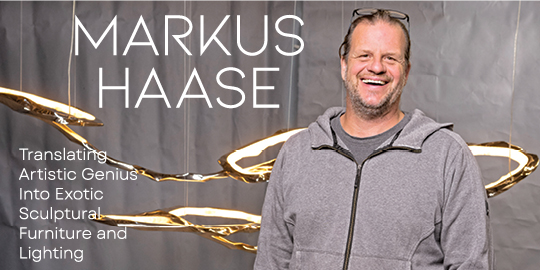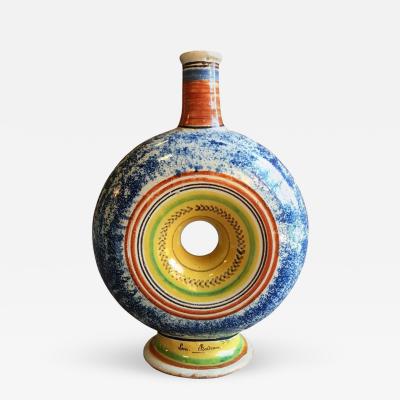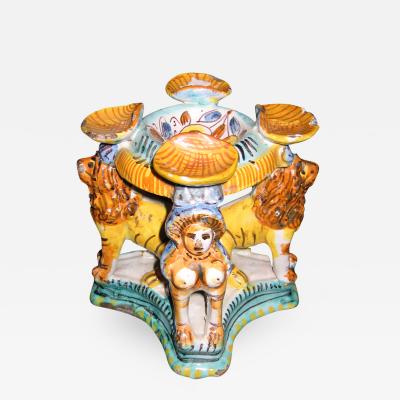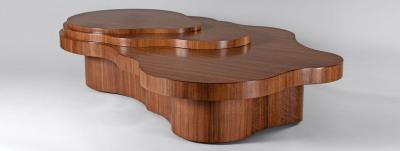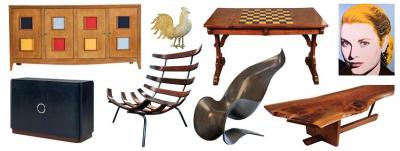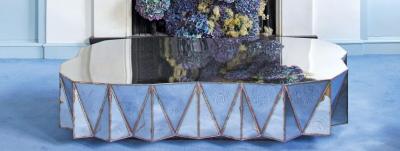A contemporary townhouse in a quiet hillside neighborhood overlooking the skyscrapers of downtown Minneapolis is the setting for a spectacular Americana collection. The collection is diverse, from nineteenth-century silhouettes and woven baskets to brass candlesticks and Dutch ceramics, but it is distinguished by its examples of eighteenth-century New England furniture and nineteenth-century New England folk portraits.
 - The welcoming foyer of the collectors’ home contains a formal display of New England furniture that includes a Chippendale mahogany serpentine chest of drawers, with ball-and-claw feet and ornate brass pulls, that descended in the Roberts and Clark families of Hartford, Connecticut. The chest is flanked by two Boston Queen Anne walnut side chairs. The walnut mirror with gilded carving was formerly in the collection of Mr. and Mrs. Adolph Henry Meyer.
|
 - The avid Americana collector Nina Fletcher Little bought this vibrantly colorful John Usher Parsons portrait of Harriet Paddleford Goodnow (ca. 1837) from Goodnow descendants after it returned to New England from a sojourn in Manhattan, Kansas. Little wrote in Little By Little (1984) that the painting embodies “the spirit of true folk art as rendered by an intuitive, although untrained, hand....” The portrait hangs above a Boston block-front chest of drawers from Wayne Pratt.
|
 - The fireplace wall has pendant portraits of Mary Christopher Van Doorn Couch and John Whitfield Couch, purchased from Hirschl & Adler Galleries. The painter is Ammi Phillips, referred to by the collectors as the “Picasso of American folk art.” Both portraits are dated 1829 and retain their original frames decorated with painted leaves. The couple acquired the center Ammi Phillips portrait of Catharina Van Keuren (ca. 1819) through Milly McGehee. A bold Boston block-front kneehole bureau from Wayne Pratt, a Chippendale cherry lolling chair (against the wall), and a New York mahogany lolling chair (with original upholstery under modern show cover) represent some of the more formal New England furniture in the couple’s collection. Early American porringers and a variety of ceramics are displayed among a selection of the couple’s extensive collection of brass candlesticks purchased from Nathan Liverant and Son and Ed Weissman, among others. Also purchased from Liverant is the Suffield, Connecticut, rectangular tray-top cherry tea table (ca. 1745), with its bold, architectural molding, pull-out candle slides, and graceful legs with whimsical Spanish, brush-shaped feet. Formerly in the collection of Charles S. Bissell, author of Antique Furniture in Suffield Connecticut 1670–1835 (1956), it appears in John Kirk’s Connecticut Furniture, Seventeenth and Eighteenth Centuries, the catalogue that accompanied the exhibition of the same name at the Wadsworth Atheneum in 1967.
|
 - above The bay window provides a forested view with the Minneapolis skyline and the Mississippi River beyond. A lower Delaware Valley Chippendale tilt-top tea table, from Samuel Herrup, sits between a Massachusetts lolling chair from Liverant and a late New England wing chair. The table displays a maple-framed Pennsylvania German baptismal certificate for Emily Ann Rockey (1845). A nearly identical certificate for Emily’s sister, Mary Jane, is in the Philadelphia Museum of Art.
|
 - The south wall of the living room is decorated with signed portraits (ca. 1852) by William Matthew Prior (1806–1873) depicting Captain Christopher Andrews of Massachusetts, his wife, Ruth Andrews, and his four children. Formerly in the collection of the Dietrich American Foundation, the portraits were once exhibited at the Portland Museum of Art in Maine. They are on either side of a Colchester, Connecticut, high chest of drawers (ca. 1770) purchased from Arthur Liverant. The name “Pomeroy” is inscribed in the middle top drawer. One of the most important pieces of Connecticut furniture in the couple’s collection, the chest was probably made for Reverend Benjamin and Abigail Pomeroy. It was the focus of an article by William Lamson Warren, “The Pomeroy High Chest of Drawers, An Exercise in Attribution,” in the Connecticut Antiquarian (June 1980). The two Norwich Queen Anne cherry side chairs are similar to those owned by William Pitkin, a colonial Governor of Connecticut; they were purchased from Israel Sack.
|
 - A panoramic view of the dining room, kitchen, and intimate garden beyond with a patinated copper flower planter shaped like a Palladian window. Skillfully embroidered designs originated by the wife are seen on the seats of the Colonial Revival chairs in the dining room. The John Brewster Jr. portrait of a young woman (ca. 1810) was formerly in the Howard and Catherine Feldman collection.
|


- The couple first saw the Orlando Hand Bears portrait of Ann Dusenberry (right) and her sister Eliza (ca. 1838) hanging in the Detroit-area home of collector Stanley Paul Sax. Eliza’s sullen facial appearance and the placement of white coral in her hand suggests her portrait is posthumous. The painting hangs over a Boston Federal mahogany and marble top sideboard.
The couple began in earnest their excursion into collecting after seeing The Flowering of American Folk Art, 1776–1876 in 1974 at the Whitney in New York City. “It was like an epiphany,” says the wife. This important exhibition introduced the collectors to the world of eighteenth- and nineteenth-century folk art and essentially spawned a private collection. Drawn to work by self-trained artists, the couple decided to concentrate on folk art portraits. Meanwhile, successful experiences at estate sales in the Twin Cities and answering antiques advertisements presaged the ultimate strength of the furniture collection. After the inaugural Minneapolis Institute of Arts Antiques Show and Sale in 1984 the couple began to seek out furniture from Boston and Connecticut.
While the collectors claim they are not academics, their interest in research is commendable as is their comprehension of historic integrity in art. A sensitivity to condition is maintained throughout their collection, from the preserved, mahoganized finish of their cherry bonnet-top Connecticut high chest of drawers (ca. 1770) to the original, now crackled surface of an oil on canvas portrait of a woman with a rose by Ammi Phillips (1788–1865).
The collectors are aided by solid contacts within The Minneapolis Institute of Arts (MIA) and the Upper Midwest Conservation Association (based at the MIA). The wife is a docent at the MIA and the husband is an active museum trustee, fundraiser, and organizer of the museum’s annual antiques show and sale. They recently endowed a gallery to exhibit the museums’ collection of American folk art. “Through programs and trips organized by the MIA curators and sponsored by the museum’s paintings and decorative arts councils, we have sharpened our eyes and gained considerably more knowledge in connoisseurship and conservation,” says the husband. The couple’s acquisitions also support museum research. Their purchase of a painted box with New England village scenes attributed to the artist Daniel Evans was suggested to them by Christopher Monkhouse, the James Ford Bell Curator at the MIA, at present researching the work of Evans.
 - The collectors’ most recent acquisition is the Sheldon Peck portrait of Oscar Gilbert Adams (ca. 1828) purchased from Sotheby’s in May of this year. The child appears to project from the painting, as though sliding forward with his outstretched foot on the fancy painted and richly upholstered settee. The trompe l’oeil effect continues below the portrait in an early-nineteenth century wooden box decorated with painted tassels and swags against a black background to resemble the painted tinware boxes of the period; purchased by Milly McGehee. The captivating bird’s-eye maple Portsmouth, New Hampshire, sideboard came through Israel Sack. The couple bought the Jacob Maentel portrait of a woman in Empire dress (ca. 1800) at a Sotheby’s auction.
|
 - In the dining room, the John Brewster Jr. portrait of Rebecca Warren and “Fair Musicians,” her painted and silk needlework (ca. 1805), were purchased together from Arthur Liverant at the Philadelphia Antiques Show. The Federal grouping hang above a Rhode Island Federal Pembroke table (ca. 1790) adorned on its top with a rare, large inlaid patera; purchased through Milly McGehee at Northeast Auctions. Joshua Johnson painted the portrait of Richard John Cock (1808–1817), displayed over a Norwich, Connecticut, side chair (ca. 1750), attributed to the workshop of Colonel Simon Lathrop and upholstered in eighteenth-century leather salvaged from the Danish ship Die Frau Metta Catharina, wrecked in 1786 off the English coast. Visible in the entry beyond is an Aaron Willard mahogany tall case clock, Roxbury, Massachusetts.
|
 - The impressive display of Dutch tin-glazed earthenware in the inviting kitchen includes a rare complete set of plates depicting the twelve stages of the herring catch made by De Porceleyne Bijl’ (The Porcelain Axe) factory in Holland (ca. 1780) and purchased from Aronson of Amsterdam in 1997 at the East Side House Settlement Winter Antiques Show in New York City. Samuel Herrup provided the Queen Anne drop-leaf table with red paint, which descended in Ebeneezer Breed’s family of Weare, New Hampshire. The Massachusetts maple drop-leaf table with mahoganized finish situated against the windows belonged to period room promulgator Katharine Prentis Murphy and was previously in the collection of the New-York Historical Society.
|
 - The niche in which this flat-top high chest of drawers, from Wayne Pratt, is placed suggests a case within a case for an elegant cherry example of colonial Connecticut craftsmanship. The flat front of this example is decorated with carved sunbursts on the top and bottom center drawers and fairly straight cabriole legs that terminate in pointed boot feet.
|
 - The deep walk-in closet provides an appropriate space for displaying a circa 1818 Zedekiah Belknap (1781–1858) portrait of Elizabeth Barber Smith (1796–1833), bedecked in modish costume. She is adjacent to a nineteenth-century silhouette of a descendent of the Revolutionary War hero Nathan Hale of Connecticut. The portraits are seen with a flame stitch bag and a Massachusetts Chippendale mahogany chair, both bought from Minnesota dealer Robert Riesberg.
|
 - Above the fireplace in the couple’s study hangs a portrait by Ammi Phillips of a woman adorned with intricately detailed lace. The portrait is flanked by a Pennsylvania walnut side chair and a Connecticut candlestand with compass inlay on its dish-top, previously in the collection of Nathan Liverant. The couple acquired the decorated tinware box this year from Arthur Liverant at the Philadelphia Antiques Show. A monumental nineteenth-century English transfer-printed pitcher is placed in front of the firebox.
|

- A portrait of the Reverend William Mason, ca. 1800, spotted by the wife at a Northeast Auctions sale in Portsmouth, N.H., in 2002, hangs in the couple’s second-floor master bedroom. At the same sale, the couple acquired the Federal tiger and bird’s-eye maple card table with serpentine rails; both were acquired through Milly McGehee. They bought the painted nineteenth-century European box on the table at the Sotheby’s sale of the Meyer collection. A hanging crazy quilt (ca. 1884), purchased from Stella Rubin, and a New York quilt (ca. 1845) decorate the nineteenth-century maple bed with boldly turned posts. To its left is a Rhode Island Federal Pembroke table purchased in Minneapolis.
The couple’s commitment to the MIA extends to significant donations, such as the five-piece garniture of Dutch tin-glazed earthenware, decorated with rococo and chinoiserie designs, and a mid-nineteenth century portrait of a woman from Lombard, Illinois, painted by Sheldon Peck (1797–1868) after he made the western exodus from Vermont to the greater Mississippi valley in the mid-1830s. The collectors recently filled the void left by the donated Peck with an earlier portrait by the artist, that of the infant Oscar Gilbert Adams from Harpersfield, New York (ca. 1828), which hangs above a bird’s-eye maple Portsmouth, New Hampshire, butler’s sideboard. Replete with the rigidly sculpted face and stiff posture that are characteristic of Peck’s oeuvre, the portrait also contains part of a handsomely painted fancy settee. A similar blending of the couple’s interests in portraits and furniture contributed to their purchase of the Orlando Hand Bears (1811–1851) portrait, circa 1838, of the Dusenberry sisters of White Plains, New York, which positions the sitters with a beautifully grained mahogany chest of drawers. The portrait hangs above a white marble-top Federal sideboard (ca. 1790) similar to the work of John and Thomas Seymour in Boston, and acquired, like the Peck portrait and other paintings in the collection, through Maryland dealer Milly McGehee, who has served as a consultant for the couple on many acquisitions.
The collectors buy regularly at Sotheby’s and Christie’s in New York City, at Northeast Auctions in Portsmouth, and from dealers in the Twin Cities. They have forged trusted relationships nationally with such prominent Americana dealers as Arthur Liverant, and Harold and Albert Sack of Israel Sack, Inc. “It’s important for us to find people who have our vision,” says the husband. Some of the earliest acquisitions of New England furniture were acquired through Israel Sack, such as a Chippendale cherry lolling chair and, later, two Norwich, Connecticut, Queen Anne side chairs.
 - A tiger maple chest of drawers from Israel Sack, with fluted and turned legs and pressed brass pulls, is the setting for an eclectic display of objects. Beside the nineteenth-century painted box and silver-plated candlesticks are woven baskets acquired through Douglas L. Solliday (Missouri) at the annual Minneapolis Institute of Arts Antiques Show and Sale. The Federal mahogany mirror with shell inlay was also purchased in Minnesota.
|
 - This Queen Anne cherry dressing table, the collectors’ first piece of Connecticut furniture, was purchased during the 1976 bicentennial year. The patriotic impetus continues with an ink and silk memorial to George Washington, with Mount Vernon in the background, made by Rosanna McCune in September 1827. The scene is based on an engraving by Samuel Seymour and published by J. Savage in 1804, entitled “In Memory of Genl George Washington and His Lady.” The framed needlework, provided by Milly McGehee, hangs above a rare painted box probably decorated in the 1830s or 1840s by the Maine artist Daniel Evans.
|

- A Queen Anne Boston side chair, sold to the couple by Israel Sack, Inc., provides a hint of the eighteenth century in this contemporary bathroom. The nineteenth-century theorem or stencil painting of a bountiful fruit compote was purchased from Raccoon Creek Antiques at the 2003 Minneapolis Institute of Arts Antiques Show and Sale.
Their furniture interests have lately focused on pieces from Connecticut, many of which come through Arthur Liverant of Nathan Liverant and Son in Colchester; described by the couple as “the quintessential Connecticut dealer.” Liverant has even encouraged the wife’s artistic talents, providing her with historic crewelwork patterns for seat covers. In the late 1990s, the couple purchased from Liverant the pièce de résistance of their Connecticut furniture collection, a Suffield cherry tea table (ca. 1745). “With its high arched knee and delicate cuffs, the table comes alive for us,” says the husband. “It springs forward, as though it wants to move.” “It’s a wonderful piece of sculpture,” adds the wife. Well-lit, free-flowing, gallery-like spaces in the collectors’ four-level, urban home are conducive to seeing paintings and furniture, such as the table, as individual works of art. Integration and rotation of art of different media “keeps our collection fresh,” says the wife, “and allows us to see work in a different light.”
The couple is keenly aware of the antiques and folk art markets and trends, and has acquired a great deal of collecting savvy. “Our whole concept is discipline,” says the husband. He continues, “When it comes to furniture, we’re focused on great form, original surface, and rarity. When we buy a folk art painting, we get the best we can afford.” Rarity and provenance have guided the acquisition of works like the portrait of Richard John Cock by the famous biracial artist Joshua Johnson (1765–1830). The portrait descended in the Cock family of Baltimore until it was acquired by Hirschl & Adler Galleries and purchased by the collectors in 2004. Other objects have equally illustrious histories. A Massachusetts drop-leaf table, with pronounced pad feet and hocked ankles, was formerly in the collection of Katharine Prentis Murphy; credited with generating numerous museum period rooms in places like Shelburne Museum, the New Hampshire Historical Society, and Bayou Bend. Collectors Bertram and Nina Fletcher Little, whose home in now administered by Historic New England, once owned the couple’s John Usher Parsons portrait of Harriet Paddleford Goodnow (ca. 1837).
Learning from these mentors, the passionate collectors also enjoy the continual sharing of information. Objects and art from their collection appear in catalogues and have been recently exhibited for the public at The Minneapolis Institute of Arts. “And as the future of our collection is in Minneapolis,” says the wife, “we love to inspire other collectors in the community and exchange ideas with them.” The husband adds, “Discussing a new purchase, the next exciting piece that enhances a collection, is the story of our lives.”
This article was originally published in the Autumn/Winter 2005 issue of Antiques & Fine Art magazine, which is affiliated with Incollect.com.
By
Jason T. Busch
Contributors
Photography by Daniel Dennehy
Nov 4,2013
Jason T. Busch is associate curator of architecture, design, decorative arts, craft & sculpture at The Minneapolis Institute of Arts.

















